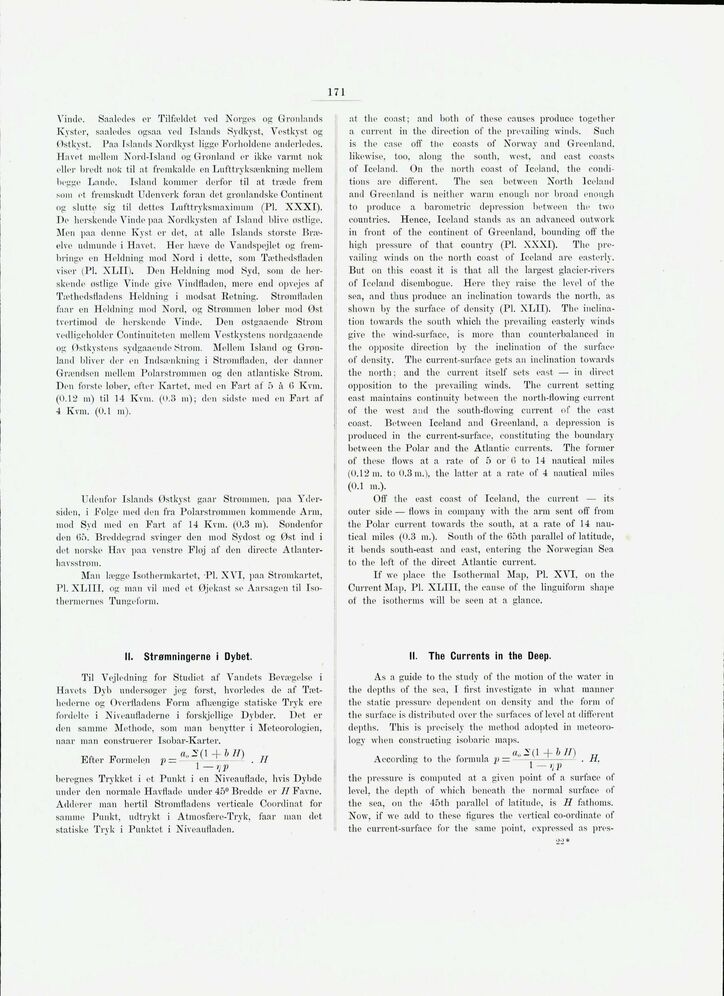
Full resolution (JPEG) - On this page / på denna sida - Sidor ...

<< prev. page << föreg. sida << >> nästa sida >> next page >>
Below is the raw OCR text
from the above scanned image.
Do you see an error? Proofread the page now!
Här nedan syns maskintolkade texten från faksimilbilden ovan.
Ser du något fel? Korrekturläs sidan nu!
This page has never been proofread. / Denna sida har aldrig korrekturlästs.
171
Vinde. Saaledes er Tilfældet ved Norges og Grønlands
Kyster, saaledes ogsaa ved Islands Sydkyst, Vestkyst og
Østkyst. Paa Islands Nordkyst ligge Forholdene anderledes.
Havet mellem Nord-Island og Grønland er ikke varmt nok
eller bredt nok til at fremkalde en Lufttryksænkning mellem
begge Lande. Island kommer derfor til at træde frem
som et fremskudt Uden verk foran det grønlandske Continent
og slutte sig til dettes Lufttryksmaximum (Pl. XXXI).
De herskende Vinde paa Nordkysten af Island blive østlige.
Men paa denne Kyst er det, at alle Islands største
Bræ-elve udmunde i Havet. Her hæve de Vandspejlet og
frembringe en Heldning mod Nord i dette, som Tæthedsfladen
viser (Pl. XLII). Den Heldning mod Syd, som de
herskende østlige Vinde give Vindfladen, mere end opvejes af
Tæthedsfladens Heldning i modsat Retning. Strømfladen
faar en Heldning mod Nord, og Strømmen løber mod Øst
tvertimod de herskende Vinde. Den østgaaende Strøm
vedligeholder Continuiteten mellem Vestkystens nordgaaende
og Østkystens sydgaaende Strøm. Mellem Island og
Grønland bliver der en Indsænkning i Strømfladen, der danner
Grændsen mellem Polarstrømmen og den atlantiske Strøm.
Den første løber, efter Kartet, med en Fart af 5 å 6 Kvm.
(0.12 m) til 14 Kvm. (0.3 m); den sidste med en Fart af
4 Kvm. (0.1 ni).
Udenfor Islands Østkyst gaar Strømmen, paa
Ydersiden, i Følge med den fra Polarstrømmen kommende Arni,
mod Syd med en Fart af 14 Kvm. (0.3 m). Söndenfor
den 05. Breddegrad svinger den mod Sydost og Øst ind i
det norske Hav paa venstre Fløj af den directe
Atlanter-havsstrøm.
Man lægge Isothermkartet, PI. X VI, paa Strømkartet,
PI. XLIII, og man vil med et Øjekast se Aarsagen til
Isotherm er nes Tun gef< inn.
at the coast; and both of these causes produce together
a current in the direction of the prevailing winds. Such
is the case off the coasts of Norway and Greenland,
likewise, too, along the south, west, and east coasts
of Iceland. On the north coast of Iceland, the
conditions are different. The sea between North Iceland
and Greenland is neither warm enough nor broad enough
to produce a barometric depression between the two
countries. Hence, Iceland stands as an advanced outwork
in front of the continent of Greenland, bounding off the
high pressure of that country (Pl. XXXI). The
prevailing winds oil the north coast of Iceland are easterly.
But on this coast it is that all the largest glacier-rivers
of Iceland disembogue. Here they raise the level of the
sea, and thus produce an inclination towards the north, as
shown by the surface of density (Pl. XLII). The
inclination towards the south which the prevailing easterly winds
give the wind-surface, is more than counterbalanced in
the opposite direction by the inclination of the surface
of density. The current-surface gets an inclination towards
the north; and the current itself sets east — in direct
opposition to the prevailing winds. The current setting
east maintains continuity between the north-flowing current
of the west and the south-flowing current of the east
coast. Between Iceland and Greenland, a depression is
produced in the current-surface, constituting the boundary
between the Polar and the Atlantic currents. The former
of these flows at a rate of 5 or 6 to 14 nautical miles
(0.12 m. to 0.3 m.), the latter at a rate of 4 nautical miles
(0.1 m.).
Off the east coast of Iceland, the current — its
outer side — flows in company with the arm sent off from
the Polar current towards the south, at a rate of 14
nautical miles (0.3 m.). South of the 65th parallel of latitude,
it bends south-east and east, entering the Norwegian Sea
to the left of the direct Atlantic current.
If we place the Isothermal Map, Pl. XVI. on the
Current Map, PI. XLIII, the cause of the linguiform shape
of the isotherms will be seen at a glance.
II. Strømningerne i Dybet.
Til Vejledning for Studiet af Vandets Bevægelse i
Havets Dyb undersøger jeg først, hvorledes de af
Tæthederne og Overfladens Fonn afhængige statiske Tryk ere
fordelte i Niveaufladerne i forskjellige Dybder. Det er
den samme Methode, som man benytter i Meteorologien,
naar man construerer Isobar-Karter.
Efter Formelen p=a"-({±hHl . Jf
1 — yp
beregnes Trykket i et Punkt i en Niveauflade, hvis Dybde
uncler den normale Havflade under 45° Bredde er 11 Favne.
Adderer man hertil Strømfladens verticale Coordinat for
samme Punkt, udtrykt i Atmosfære-Tryk, faar man det
statiske Tryk i Punktet i Niveaufladen.
II. The Currents in the Deep.
As a guide to the study of the motion of the water in
the depths of the sea, I first investigate in what manner
the static pressure dependent on density and the form of
the surface is distributed over the surfaces of level at different
depths. This is precisely the method adopted in
meteorology when constructing isobaric maps.
According to the formula v — -’- ~^ . H.
I — ijp
the pressure is computed at a given point of a surface of
level, the depth of which beneath the normal surface of
the sea, on the 45th parallel of latitude, is H fathoms.
Now, if we add to these figures the vertical co-ordinate of
the current-surface for the same point, expressed as pres-
<< prev. page << föreg. sida << >> nästa sida >> next page >>